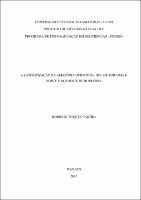| ???jsp.display-item.social.title??? |


|
Please use this identifier to cite or link to this item:
https://tede.ufam.edu.br/handle/tede/5405| ???metadata.dc.type???: | Dissertação |
| Title: | A lateritização na Amazônia Ocidental: sul de Roraima e norte e noroeste de Rondônia |
| ???metadata.dc.creator???: | Castro, Rodrigo Tokuta  |
| ???metadata.dc.contributor.advisor1???: | Horbe, Adriana Maria Coimbra |
| First advisor-co: | Almeida, Caroline Michelin de |
| ???metadata.dc.description.resumo???: | Este trabalho aborda o contexto laterítico com base nos aspectos texturais, mineralógicos, geoquímicos. Na região da Vila Nova Colina no centro sul do estado de Roraima, há dois tipos de crostas lateríticas: (i) vermiforme ferruginosa com elevados teores de caulinita, goethita, hematita, magnetita e anatásio e maior concentração de Al2O3, Sc, Th, e Zr desenvolvida sobre granitos e, (ii) maciça ferro-titanífera com altos teores de magnetita, hematita, maghemita, goethita, caulinita, anatásio, gibbsita e ilmenita e de Fe2O3, TiO2, V e Cu desenvolvida a partir de quartzo-hornblenda gabro. A crosta maciça em posição topográfica mais elevada (220 m) e sua composição mineralógica e geoquímica, indicam maior maturidade que a crosta vermiforme em cota mais baixa (140 m). Além disso, a presença de gibbsita na crosta maciça, indica que ela é relicto de uma fase erosiva na centrosul de Roraima, provavelmente associada a subsidência da bacia do Tacutu no Mioceno. Na região norte e noroeste de Rondônia ocorrem perfis lateríticos desenvolvidos a partir de monzogranitos do cráton Amazonas (p.e. Suítes Intrusivas Serra da Providência, Santo Antônio, São Lourenço-Caripunas e Laje). Os perfis são completos e incompletos de acordo com o estágio de evolução/truncamento. O saprólito e o horizonte mosqueado são formados por caulinita, quartzo, goethita, rutilo/anatásio, muscovita, illita e albita marcados por teores mais elevados em Al2O3, PF, Nb, Pb, Th, U e Zr. As crostas lateríticas exibem textura vermiforme e colunar, localmente pisolíticas com maior conteúdo de goethita, gibbsita e hematita e de Fe2O3, SiO2, Al2O3, PF, TiO2, Ga, Hf, Nb, Sc, Th, U, V e Zr. Os solos, no topo dos perfis são quimicamente similares as crostas sobrepostas. Assim como em Roraima, os perfis são remanescentes de uma fase erosiva associada ao esculpimento da Chapada dos Parecis e a formação do traçado atual do rio Madeira. A estrutura dos perfis e a ausência de crosta bauxítica, indicam estrutura típica de perfis pouco evoluídos desenvolvidos a partir do Plio-Pleistoceno, época da segunda fase de lateritização na Amazônia. |
| Abstract: | This paper approaches the laterite context based on textural, mineralogical, geochemical aspects. In the region of Vila Nova Colina south of the state of Roraima, the profiles have two types of lateritic crusts: (i) the ferruginous vermiform one with high amounts of kaolinite, goethite, hematite, magnetite and anatase, higher concentration of Al2O3, Sc, Th e Zr developed on granites and, (ii) the iron-titaniferous massive crust with high amounts of magnetite, hematite, maghemite, goethite, kaolinite, anatase, gibbsite and ilmenite, and consequently in higher amounts of Fe2O3, TiO2, V e Cu developed from quartz-hornblende gabbro. The higher topographic position of the massive crust (220 m) and its mineral and geochemical composition, indicate higher maturity than the vermiform crust on lower topographic position (140 m). The presence of gibbsite on the massive crust and its higher topographic position at the regional scale, indicates that it is relict of an erosive phase in the center-south of Roraima, probably associated with subsidence of the Tacutu basin in Miocene. In the north and northwest of Rondônia occur lateritic profiles developed from monzogranites of the Amazon craton (e.g. Serra da Providência, Santo Antônio, São Lourenço-Caripunas and Laje Intrusive Suite). The profiles are complete and incomplete according to the stage of evolution/truncation. The saprolite and mottled horizon consist of kaolinite, quartz, goethite, rutile/anatase, muscovite, illite, and albite marked by higher levels of Al2O3, PF, Nb, Pb, Th, U and Zr. The crusts lateritic show vermiform texture and columnar, pisolitic locally with higher content of goethite, hematite and gibbsite and Fe2O3, SiO2, Al2O3, PF, TiO2, Ga, Hf, Nb, Sc, Th, U, V and Zr. The soils on the top of the profiles are chemically similar to those crusts. As well as Roraima the profiles are remnants of an erosive phase, associated with the sculpting of Chapada dos Parecis and the formation of the current route of the Madeira River. The structure of profiles and the absence of bauxitic crust indicate typical structure of little evolved profiles developed from the Plio-Pleistocene, time of the second lateritization phase in the Amazon. |
| Keywords: | Geologia regional Mineralogia Geoquímica |
| ???metadata.dc.subject.cnpq???: | CIÊNCIAS EXATAS E DA TERRA: GEOCIÊNCIAS |
| Language: | por |
| ???metadata.dc.publisher.country???: | Brasil |
| Publisher: | Universidade Federal do Amazonas |
| ???metadata.dc.publisher.initials???: | UFAM |
| ???metadata.dc.publisher.department???: | Instituto de Ciências Exatas |
| ???metadata.dc.publisher.program???: | Programa de Pós-graduação em Geociências |
| Citation: | CASTRO, Rodrigo Tokuta. A lateritização na Amazônia Ocidental: sul de Roraima e norte e noroeste de Rondônia. 2015. 74 f. Dissertação (Mestrado em Geociências) - Universidade Federal do Amazonas, Manaus, 2015. |
| ???metadata.dc.rights???: | Acesso Aberto |
| URI: | http://tede.ufam.edu.br/handle/tede/5405 |
| Issue Date: | 30-Sep-2015 |
| Appears in Collections: | Mestrado em Geociências |
Files in This Item:
| File | Description | Size | Format | |
|---|---|---|---|---|
| Dissertação - Rodrigo Tokuta Castro.pdf | 4.73 MB | Adobe PDF |  Download/Open Preview |
Items in DSpace are protected by copyright, with all rights reserved, unless otherwise indicated.




